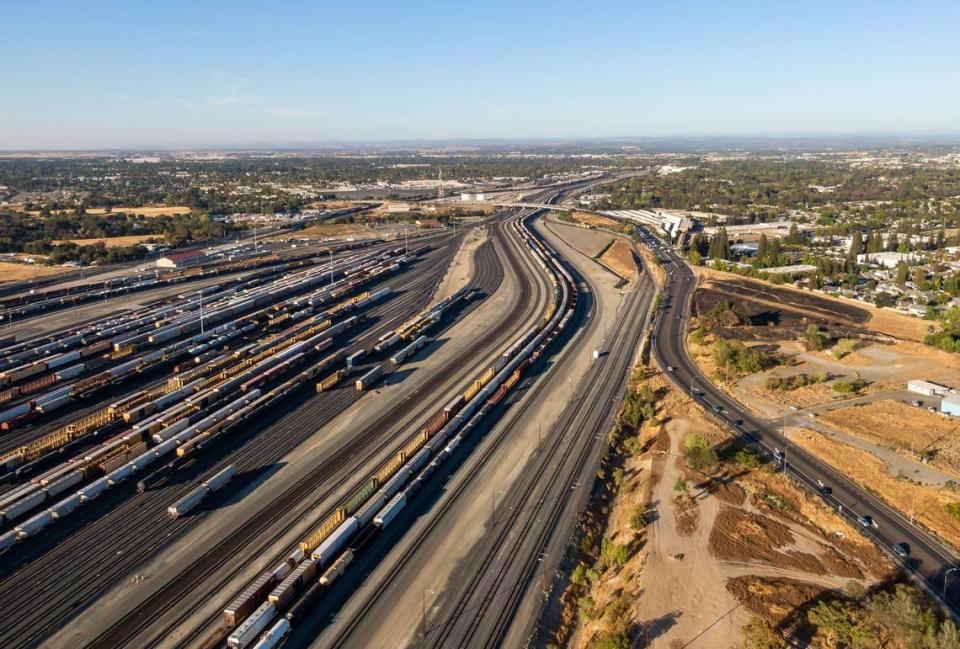California OKs landmark ban on sales of diesel big-rig trucks by 2036, limits train emissions
The state’s top air regulator rang a death knell for diesel in California this week by ruling to eliminate dirty fuel from its trucking and train industries, moves that promised cleaner air for millions over time.
By banning the sale of new diesel trucks in 2036 and ordering all trains to be carbon-free by 2047, the California Air Resources Board regulations aim to drastically lower levels of tailpipe exhaust that harm human health and contribute to atmospheric warming.
“This is an absolutely transformative rule to clean our air and mitigate climate change,” said air board chair Liane Randolph before a Friday morning vote. “We all know there’s a lot of challenges, but those challenges aren’t going to be tackled unless we move forward ... if not now, when?”
Freight trucks moved 8.3 million tons of goods worth $1.2 billion last year, Department of Transportation data show. Despite making up just 7% of vehicles on California roads, big-rigs are the single largest source of vehicle air pollution.
Truck engines emit about 70% of smog-forming nitrogen oxides and 80% of carcinogenic diesel soot, according to the air board. Trains are also big polluters, the air board said, making up about 15% of nitrogen oxide pollution in the entire freight industry.
Much of this industrial pollution is felt most acutely in communities that live closest to ports and warehouses, including the southern Central Valley, Los Angeles County and the Inland Empire, leading to higher rates of asthma and breathing problems.

Carbon-free trucks ahead
The air board’s rule passed Friday forbids manufacturers of non-passenger vehicles from delivery vans to semi-trucks from selling any non-zero emission vehicle starting in 2036. The regulation also targets owners of truck fleets, requiring them to switch to zero-emission vehicles over time.
It would first kick in for drayage trucks, which move cargo between ports and warehouses up and down the state. Existing diesel vehicles can operate for several more years, but any new vehicles must be zero emission beginning in 2024 and all must be converted to electric by 2035.
A requirement to switch existing trucks to zero emissions by 2042 would also apply to groups of 50 or more owned and operated by companies with more than $50 million in annual revenue, called “high-priority fleets,” as well as federally-owned trucks.
That includes both heavy-duty big-rigs weighing 8,500 pounds or more as well as lighter vehicles that include package delivery vans operated by the U.S. Postal Service, UPS and Amazon.
Requirements for public agencies such as fire departments and water agencies would also approach rapidly. Truck-owning agencies must make half of their truck purchases zero emission by 2024, ramping up to 100% by 2027, but emergency vehicles are exempt.
Environmental justice advocates in some of the most polluted regions of California have been key proponents of the regulation, pushing for more stringent measures and timelines. Sharing stories of longstanding health issues, they celebrate the rule as paving a healthier for future generations.
Warehouse worker Julieta Fuentes gave testimony Thursday on behalf of Isabel, an 18-year-old girl in her Inland Empire community who was diagnosed with asthma at age 4. She grew up being told by her parents not to run, jump, exercise and go outside.
“Chronic disease as serious as asthma makes you live in fear and anger, and ask yourself in the morning, ‘Why me?’ If only I could live a normal life without having to depend on an inhaler,” she said. “I’ll be graduating high school soon but I’m not satisfied. My childhood was taken from me.”
Trucking companies and local governments have emerged as key critics of the regulation. They argue timelines are difficult to meet given a limited availability of zero-emission trucks with long-range and a dearth of adequate charging infrastructure.
“There are many of us in the drayage industry that run our trucks 400 miles plus a day ... how will those of us buy something that does not exist?” Cory Peters, CFO at Best Drayage based in Oregon said. “This will have a devastating effect on Central Valley shippers who rely on getting their goods to the rest of the world.”
Cleaner trains
Under the rule to clean up trains passed Thursday, most diesel locomotives older than 23 years must be retired and replaced with an electric alternative beginning in 2030. All locomotive fleets must go electric by 2047.
As soon as 2024, operators are required to fund a spending account based on their trains’ own emissions — the dirtier the locomotive, the more funds must be set aside for investment in zero-emission alternatives. Idling will also not be permitted for longer than 30 minutes.
Beginning in 2030, 50% of locomotive fleets must adopt updated technology to clean up some emissions. And by 2042, 50% of all fleets must be electric or other zero-emission trains.
Environmentalists celebrated the ruling, who say locomotives in California and the rest of the nation are long overdue for modernization. About one-quarter of the world’s rail lines are already electric, they point out.
Yet industry representatives have said throughout the process that the measures are coming too soon. They say implementing this regulation will be too expensive and lead to higher prices for goods.
“There is no clear path to zero emissions locomotives,” the Association of American Railroads said in a statement. “Mandating that result ignores the complexity and interconnected nature of railroad operations and the reality of where zero emission locomotive technology and the supporting infrastructure stand. “

